Virginia HOT lanes
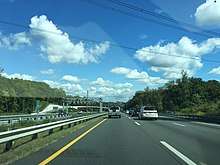
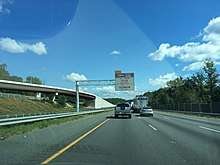
Virginia HO/T lanes refers to five separate projects in the U.S. state of Virginia. The first project, completed in November 2012, has added high-occupancy/toll (HO/T) lanes to the Capital Beltway (I-495) in Fairfax County. The second project, opened to the public in December 2014, involved converting and extending the existing reversible high-occupancy vehicle (HOV) lanes on I-95 and I-395 to HO/T lanes from Stafford to near Alexandria. The third project converted existing HOV lanes inside the beltway on Interstate 66 to HO/T lanes, opening on 4 December 2017. The fourth project will convert the existing high-occupancy vehicle (HOV) lane outside the beltway on Interstate 66 and add a second lane to HO/T lanes. The fifth project will convert the existing reversible high-occupancy vehicle (HOV) lanes on I-395 to HO/T lanes from near Alexandria to Washington, DC. The sixth project will convert the existing reversible HOV Lanes to HOT Lanes on Interstate 64 from Interstate 564 in Norfolk to Interstate 264 in Virginia Beach, and also propose to expand the I-64 Express Lanes before and after the HOT Lanes.
495 Express Lanes
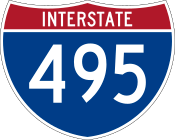
The 495 Express Lanes, also known as the E-ZPass Express Lanes, are a 14-mile segment of I-495 extending from the Springfield Interchange to a point north of the Dulles Toll Road. The project began when Virginia Department of Transportation (VDOT) signed an agreement with Fluor Corporation and Transurban in April 2005 to create HO/T lanes between Springfield and Georgetown Pike. A contract was finalized on December 20, 2007, and construction began in the summer of 2008.[1]
During construction, the existing eight-lane (four lanes per carriageway) Beltway was widened to a 12-lane facility consisting of four general-purpose lanes per side and two high-occupancy/toll express lanes per side located to the left of the general-purpose lanes. Construction required replacement of more than 50 overpasses and bridges and the reconstruction of ten interchanges.[2] The project also added direct connections between the Capital Beltway and the I-95/I-395 HOV lanes. The project cost $1.4 billion and was controversial due to concerns over its cost-effectiveness and the environmental effects (such as surface runoff and use of parkland) of widening the Capital Beltway.[3]
The lanes opened on November 17, 2012.[4] Buses, motorcycles, and vehicles with three or more people are able to use the express lanes for free; other vehicles must pay a toll. The toll rates change dynamically according to traffic conditions, which in turn regulates demand for the lanes and keep them operating at high speeds. Tolls are collected solely via electronic means using E-ZPass transponders. No cash toll booths are offered. All vehicles using the Express Lanes, including those traveling free under the HOV provision, must have a transponder; in order to travel free, vehicles need an E-ZPass Flex switchable transponder so the driver can indicate whether the vehicle qualifies for free passage.[5] There are 11 entry/exit points to the lanes.[6] State Police positioned at toll plazas are notified electronically if a vehicle is using the EZ-Pass Flex in HOV mode. If the officer suspects the vehicle does not meet the occupancy requirement, they will stop the vehicle and verify. First time HOV violators in Northern Virginia face a minimum $125 fine, with the fine doubling (and 3 demerit points added to the driver's record) for each subsequent offense.[7]
The speed limit on the lanes was increased from 55 mph to 65 mph on June 24, 2013, after a VDOT study concluded an increase would not pose a safety risk.[8] Transportation officials said they always expected the speed limit to be increased, but they needed to open the lanes with a 55 mph speed limit to observe how the lanes operated and to assess whether the limit could be increased.[9]
95 Express Lanes
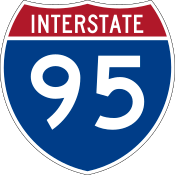
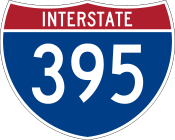
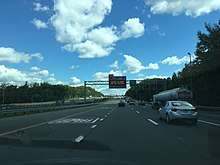
The 95 Express Lanes project is a separate public-private partnership to construct and operate HO/T lanes on a 29-mile portion of the existing reversible HOV-3 facility on I-95 and I-395. The project included construction of a nine-mile (14 km) extension of the reversible lanes from their previous southern terminus near Virginia Route 234 to Garrisonville Road (Route 610) in Stafford County. The project also added a third reversible lane within the carriageway's existing footprint from the Prince William Parkway (Virginia State Route 294) to the project's northern terminus between Duke Street (Virginia State Route 236) and Edsall Road, just south of the City of Alexandria limits; to the north of this point, the reversible facility continues to operate as it did prior to the high-occupancy/toll project.[10] The 95 Express Lanes began HO/T operations on December 29, 2014. The project had opened two weeks earlier and operated under the older HOV rules until tolling began.
Road improvements included:
- Making improvements to the existing two HOV lanes for 6 miles (9.7 km) from Route 234 to the Prince William Parkway.
- Widening the existing reversible carriageway from two lanes to three lanes for 14 miles (23 km) from the Prince William Parkway to approximately 2 miles (3.2 km) north of the Springfield Interchange in the vicinity of Edsall Road.
- Adding new or improved access points in the areas of Garrisonville Road, Joplin Road, Prince William Parkway, Fairfax County Parkway (Virginia State Route 286), Franconia-Springfield Parkway (Virginia State Route 289), I-495, and in the vicinity of Edsall Road.
- VDOT advanced plans to construct a new ramp at I-395 and Seminary Road for the Mark Center, concurrent with (but separate from) the HO/T lanes project. The ramp opened to traffic in early 2016.
- VDOT also expanded park-and-ride lots and funded other local transit improvements to maximize the benefit of the new HO/T lanes network.
- VDOT advanced studies to support the ultimate extension of HO/T lanes on I-95 south of Route 610 into Spotsylvania County.[11]
The original proposal was for the lanes to extend the entire length of the then-existing HOV facility, reaching the District of Columbia. The plan faced opposition from Arlington County, which houses a 4.5 mile stretch of I-395; the county filed a lawsuit demanding an environmental review of the proposal and contending the lanes would create congestion on streets traveling to and from I-395. In February 2011, VDOT said the lawsuit created a "detrimental" delay to the project, with Virginia Secretary of Transportation Sean Connaughton saying, "We can no longer wait to deliver congestion relief and new travel choices."[12] VDOT announced a modified plan that ends the HO/T lanes at Edsall Road in Fairfax County, avoiding the City of Alexandria and Arlington County.[12][13] As a result, the three-lane portion of the reversible carriageway, and the HO/T rules, end just north of Edsall Road. North of that point, the reversible lanes operate under the pre-existing rules imposing an HOV-3 restriction during peak hours, allowing all traffic at other times, and not requiring an E-ZPass. Drivers paying the HO/T lane tolls with fewer than three people in a vehicle are not permitted to use the reversible lanes all the way into Washington during the morning rush hour and must instead exit the reversible lanes at a new ramp north of Edsall Road constructed as part of the HO/T project; similarly, during the afternoon rush hour toll-payers with fewer than three people in a vehicle may not enter the reversible lanes north of that same location.
Since the original portion of the HOV facility opened in the 1970s, an informal car pool system called "slugging"[14] has evolved around the reversible lanes. Drivers of cars with only one or two passengers stop at designated points and pick up strangers in order to meet the HOV-3 requirement. Members of the slugging community contended that if the HO/T lanes were extended all the way to Washington, passenger utilization of the reversible lanes might decline if drivers chose to pay HO/T tolls instead of picking up passengers from slug lines. The impact on the slug lines was not addressed by VDOT or its private sector vendors in the original proposal.
395 Express Lanes
.svg.png) Interstate 395 Shield
Interstate 395 Shield I-395 Corridor
I-395 Corridor
The 395 Express Lanes project will continue the 95 Express Lanes for 8 miles from Edsall Rd to the DC line. The 395 Express lanes will operate just like the 95 express lanes, and provide new travel options in the 395 corridor. Carpools, Buses, and Motorcycles will ride for free. Carpools will also need an EZ-Pass Flex for 24/7 Toll free travel. Those willing to pay a toll for a more reliable trip can access the lanes 24.7 with an EZ-Pass. Prices will change throughout the day to maintain highway speeds on the lanes. The 395 Express Lanes will use technology and dedicated response teams to manage the lanes. Virginia State Police will enforce HOV rules on the Express Lanes. Drivers in the regular lanes will see time-saving benefits too, as the Express Lanes reduce congestion in the i-395 corridor. The project will increase capacity by adding an additional lane to make three reversible lanes on i-395 and provide dedicated funding for transit like improved bus service in the corridor.
Eads Street
The Eads Street Interchange will be modified to allow travelers to directly access the Pentagon or Crystal City using one of two reversible ramps. Traffic signals will also be added to improve circulation. The Pentagon South Parking Lot will also see improvements to benefit Pedestrians, Bus riders, Carpoolers, and Drivers.
395 Express Lanes *Continued
All other interchanges along the corridor will remain the same. However, toll paying customers will be able to access the Express Lanes at these Interchanges, even during rush hour. But the Seminary Road ramp that opened to traffic in 2016, will remain HOV only. In addition to the 395 Express Lanes, the project will deliver corridor improvements, including sound walls, a fourth southbound regular lane between Duke Street and Edsall Road, and rehabilitation of five bridges over i-395 developed. Between a Public-Private partnership with TransUrban and VDOT, construction of the 395 Express Lanes will support more than 1,000 jobs, and generate approximately 500 million dollars of regional economic activity. The 395 Express Lanes will provide congestion relief, new travel choices, and significant transit funding to Northern Virginia. Learn More at 395expresslanes.com
66 Express Lanes
I-66 Express Lanes Inside The Beltway
The I-66 Express lanes opened December 4, 2017. They are four new lanes inside the existing I-66 lanes that are dynamically tolled.[17] They are running a nine-mile stretch between Route 29 in Rosslyn and I-495. Hybrid vehicles, vehicles with Clean Special Fuel license plates, and people traveling to and from Dulles International Airport are no longer exempt. Motorcycles and vehicles carrying two or more people can use the lanes at any time.[18] These lanes are free to all drivers during off-peak periods.
The peak periods of these lanes, to maintain a minimum average speed of 45 mph, are:
- 5:30-9:30 AM Eastbound Monday through Friday
- 3-7 PM Westbound Monday through Friday
During peak periods, if drivers carpool with two or more people (HOV-2), they can travel on I-66 during rush hours for free with an E-ZPass Flex set to HOV mode to travel toll free. This will change to HOV-3 in 2022, when new express lanes open on I-66 between I-495 and University Boulevard and Route 29 in Gainesville.[19]
This is the first time that single-occupancy vehicles can use this stretch of road during these hours since 1982.[20]
See also Interstate 66#HOV designation and rules
I-66 Express Lanes Outside The Beltway
In 2022, i-66 Outside the Beltway will be transformed into a multimodal corridor, focused on moving more people, providing safer and more reliable trips, and offering new travel choices. When complete, the corridor will feature 2 Express Lanes and 3 General Purpose lanes in each direction, with ramp-to-ramp connections provided between interchanges where needed. Combined with new bicycle and pedestrian facilities, new or improved interchange configurations, new transit options and reserved median space for future transit, tomorrows I-66 will move more people and serve the needs of Northern Virginia's travelers well into the future.
Park and Ride Lots
One important element of transforming I-66 is new choices for Ridesharing and transit. New Park-and-Ride lots will be built near I-66 at the intersection of US-29 and University Blvd, and off Balls Ford Rd. at Nokes Dr. Both Park-And-Ride Lots will have a combined capacity of more than 3,000 parking spaces, including space for Commuter Buses, Kiss N' Ride areas, Carpooling, Vanpooling, and Local Shuttles, as well as Bicycle and Pedestrian accommodations. These lots will have direct access to the Express lanes.
Express Lanes Access Ramps at Sudley Rd.
New access ramps just east of Sudley Rd. will allow drivers to enter the Express Lanes from the General Purpose lanes when traveling eastbound on I-66, and to exit the Express Lanes in the westbound direction, just prior to the I-66, Sudley Rd interchange.
New Pedestrian and Bike Paths
As you enter Fairfax County, new Pedestrian and Bike facilities have been added with the corridor. Working closely with VDOT, Local Governments, Parks, Communities, and Cycling Advocates, 18 miles of new Shared Use trail will be built by Express Mobility Partners, and others. Integrating with existing and planned trails near I-66
VA Route 28 Interchange
At Route 28, interchange improvements will allow for the removal of the four traffic signals along Route 28 between I-66 and E.C. Lawrence Park by mid 2020, providing relief to the route 28 corridor. New ramps will provide direct access between Route 28 and I-66 Express and General Purpose Lanes. Braddock and Walney Roads will be reconnected with an overpass, and ramps from the new Braddock Road overpass will give direct connection to I-66
Stringfellow Road
Between Stringfellow Road and Route 28 in both the East and Westbound direction, new ramps provide access from the Express Lanes to the General Purpose Lanes. New connections between Stringfellow Road will give drivers direct access to the I-66 Express Lanes to and from the East.
Monument Drive
New ramps from Monument Drive give access to and from the Express Lanes East and Westbound direction.
Noise Walls
Noise Walls help to reduce the impact of highway traffic noise and surrounding communities. Noise wall location shown at the presentation and on the video are based upon the preliminary noise analysis final noise study. Results will be available in spring 2018.
US 50 Interchange
At Route 50, Ramps from Eastbound Route 50 to the Eastbound Express Lanes, and from Westbound Express Lanes to Westbound Route 50 are added. The redesigned interchange also features a new Shared-Use path, creating connections to surrounding communities.
Chain Bridge Rd.
The Chain Bridge RD. Interchange will be rebuilt to include four new Express Lane access ramps, to and from the East and West, and improve connections from the General Purpose lanes.
Vaden Drive
The Vaden Drive overpass will be rebuilt to include new ramps connecting the i-66 Express Lanes to and from the West with the Vienna metro station parking facilities. Only passenger vehicles, buses, and light trucks will have access at Vaden.
Nutley Street
The Nutley Street interchange will be reconfigured into a Diverging Diamond Interchange, improving movement and safety within and through the interchange
Express Lane Access Ramp East of Nutley Street
A new ramp east of Nutley Street near Prosperity Avenue provides Express Lane access from the Eastbound I-66 General Purpose lanes. This ramp will also allow drivers in the Eastbound General Purpose to access the I-495 Express Lanes
Gallows Road Overpass
The Gallows Road overpass will be rebuilt, shifting Gallows Road towards the East, creating a larger buffer between the roadway and Stenwood Elementary School, and reducing construction impact on the Dunn Loring Metro Station. To accommodate the widening of I-66, WMATA's Traction Power Substation will be relocated 1,000 feet to the west, on existing WMATA property along Prosperity Avenue.
I-495 Interchange
The I-495/I-66 Interchange will be reconfigured with six new ramps, providing direct connections between the General Purpose and Express Lanes of I-66 and I-495. The existing ramps from I-495 Northbound General Purpose and Express Lanes to I-66 Westbound will be reconfigured to provide for direct access to the I-66 Westbound Express Lanes. A new ramp will be built to replace existing connections so that I-495 Northbound travelers can still easily access the I-66 Westbound General Purpose lanes. Access Ramps from the I-496 Southbound General Purpose and Express Lanes to I-66 Westbound are reconfigured to provide travelers with the option of accessing either the I-66 General Purpose or Express Lanes.
I-66 Express Lanes Outside the Beltway *Continued
The I-66 Outside the Beltway project is an investment in multimodal travel that will help transform Northern Virginia. The combination of Express and General Purpose lanes, new transit choices, and bike and pedestrian facilities will move more people, improve safety, and reduce congestion throughout the I-66 corridor
For more information, visit transform66.org
I-64 Express Lanes
The I-64 Express Lanes are a Public-Private Partnership between Cintra and VDOT co convert the 8 Mile stretch of existing HOV lanes to Rush-Hour toll lanes.
Operating Hours are:
Westbound I-64 from 5-9 AM M-F Eastbound I-64 from 2-6 PM M-F
At all other times, the Express Lanes will be open to all traffic, like they are today. Heavy Trucks will be Prohibited on the Express Lanes, limited to Vehicles with 2 Axles ONLY. Buses, Motorcycles, and Carpools ride for free. Carpoolers will also need an EZ-Pass Flex for Toll-Free travel during Toll Hours.
VDOT is proposing to extend the I-64 Express Lanes Past the I-264 Interchange to Near the US-58 Interchange. VDOT has also proposed to build new Express Lanes in each direction on the stretch from the I-664 Interchange before the HRBT to the I-564 Interchange.
Gallery
- I-495 Construction progress
- July 2011
- July 2012
- July 2011
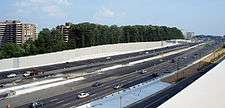 July 2012
July 2012
References
- ↑ Craig, Tim (2007-12-21). "Deals Clinched on HOT Lanes". The Washington Post. p. B01. Retrieved December 21, 2007.
- ↑ "I-495 HOT Lanes". Virginia Megaprojects. Archived from the original on 2010-02-13. Retrieved 2011-08-20.
- ↑ "HOT Lanes: Will people be willing to pay for them?". WTOP-FM. Retrieved 2010-03-01.
- ↑ "Express Lanes". Transurban (USA) Operations Inc. Retrieved 2012-11-13.
- ↑ "Frequently Asked Questions". I-495 HOT Lanes. Retrieved 2011-08-20.
- ↑ "Archived copy". Archived from the original on 2012-01-15. Retrieved 2013-06-25.
- ↑ "High Occupancy Vehicle (HOV) Lanes - Rules and FAQs". Virginia Department of Transportation. Retrieved 2015-05-19.
- ↑ Speed Limit Increases On 495 Express Lanes In Northern Va. On June 24 Archived 2013-12-21 at the Wayback Machine.
- ↑ Beltway Express Lanes speed limit raised to 65 mph
- ↑ "I-95 HOV/HOT Lanes". Virginia Megaprojects. Retrieved 2011-08-20.
- ↑ "VIRGINIA ADVANCES NEW I-95 HOV/HOT LANES PROJECT AND NEW RAMP TO SEMINARY ROAD AT MARK CENTER". Virginiadot.org. Retrieved 2011-09-19.
- 1 2 "Virginia Advances New I-95 HOV/HOT Lanes Project and New Ramp To Seminary Road at Mark Center" (Press release). Virginia Dept. of Transportation. February 3, 2010. Retrieved 2011-02-03.
- ↑ New HOT lane plan for Virginia's I-95 corridor
- ↑ "What are Sluglines". Sluglines.
- ↑ https://www.youtube.com/watch?v=KWh2XIWrwes
- ↑ http://395expresslanes.com
- ↑ Lazo, Luz (2017-12-04). "I-66 express lanes debut with $34.50 toll, among the highest in U.S." Washington Post. ISSN 0190-8286. Retrieved 2017-12-05.
- ↑ Gilgore, Sara (Nov 28, 2017). "I-66 toll lanes inside the Beltway start Monday. Here's everything you need to know". www.bizjournals.com. Retrieved 2017-12-05.
- ↑ "66 Express Lanes - Inside the Beltway :: About the Lanes". 66expresslanes.org. Retrieved 2017-12-05.
- ↑ "Dynamically Tolled Express Lanes on I-66 Set to Open in December". Fairfax County Government NewsCenter. 2017-09-06. Retrieved 2017-11-21.
- ↑ http://outside.transform66.org
